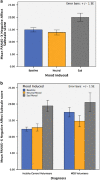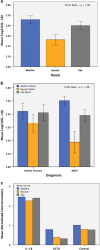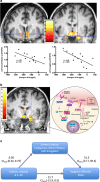Acute experimental changes in mood state regulate immune function in relation to central opioid neurotransmission: a model of human CNS-peripheral inflammatory interaction
- PMID: 26283642
- PMCID: PMC4720915
- DOI: 10.1038/mp.2015.110
Acute experimental changes in mood state regulate immune function in relation to central opioid neurotransmission: a model of human CNS-peripheral inflammatory interaction
Abstract
Although evidence shows depressed moods enhance risk for somatic diseases, molecular mechanisms underlying enhanced somatic susceptibility are ill-defined. Knowledge of these molecular mechanisms will inform development of treatment and prevention strategies across comorbid depressive and somatic illnesses. Existing evidence suggests that interleukin-18 (IL-18; an IL-1 family cytokine) is elevated in depression and implicated in pathophysiology underlying comorbid medical illnesses. We previously identified strong associations between baseline IL-18 and μ-opioid receptor availability in major depressive disorder (MDD) volunteers. Combined with the evidence in animal models, we hypothesized that experimental mood induction would change IL-18, the extent proportional to opioid neurotransmitter release. Using the Velten technique in a [(11)C]carfentanil positron emission tomography neuroimaging study, we examined the impact of experimentally induced mood (sad, neutral) on plasma IL-18 and relationships with concurrent changes in the central opioid neurotransmission in 28 volunteers (healthy, MDD). Results showed mood induction impacted IL-18 (F2,25=12.2, P<0.001), sadness increasing IL-18 (T27=2.6, P=0.01) and neutral mood reducing IL-18 (T27=-4.1, P<0.001). In depressed volunteers, changes in IL-18 were more pronounced (F2,25=3.6, P=0.03) and linearly proportional to sadness-induced μ-opioid activation (left ventral pallidum, bilateral anterior cingulate cortices, right hypothalamus and bilateral amygdala). These data demonstrate that dynamic changes of a pro-inflammatory IL-1 superfamily cytokine, IL-18, and its relationship to μ-opioid neurotransmission in response to experimentally induced sadness. Further testing is warranted to delineate the role of neuroimmune interactions involving IL-18 in enhancing susceptibility to medical illness (that is, diabetes, heart disease and persistent pain states) in depressed individuals.
Conflict of interest statement
AEK has recently been employed by Eli Lilly companies and has consulted for Metastatix, Pennside Partners, Cypress Bioscience, Takeda Pharmaceuticals, NiCox SA, Celtaxsys, Gerson Lehrman Group of Healthcare and Biomedical Advisors, Guidepoint Global, UCB Pharmaceuticals and the Fund for Autoimmune Research and has been an expert for Kirkland and Ellis. AEK has received investigator-initiated research grants for Bristol-Myers Squibb, Roche, and Takeda Pharmaceuticals. The remaining authors declare no conflict of interest.
Figures



Similar articles
-
Association of plasma interleukin-18 levels with emotion regulation and μ-opioid neurotransmitter function in major depression and healthy volunteers.Biol Psychiatry. 2011 Apr 15;69(8):808-12. doi: 10.1016/j.biopsych.2010.10.014. Epub 2010 Dec 9. Biol Psychiatry. 2011. PMID: 21145535
-
Dysregulation of endogenous opioid emotion regulation circuitry in major depression in women.Arch Gen Psychiatry. 2006 Nov;63(11):1199-208. doi: 10.1001/archpsyc.63.11.1199. Arch Gen Psychiatry. 2006. PMID: 17088500 Clinical Trial.
-
Regulation of human affective responses by anterior cingulate and limbic mu-opioid neurotransmission.Arch Gen Psychiatry. 2003 Nov;60(11):1145-53. doi: 10.1001/archpsyc.60.11.1145. Arch Gen Psychiatry. 2003. PMID: 14609890
-
Expectancy Modulation of Opioid Neurotransmission.Int Rev Neurobiol. 2018;138:17-37. doi: 10.1016/bs.irn.2018.02.003. Epub 2018 Apr 2. Int Rev Neurobiol. 2018. PMID: 29681324 Free PMC article. Review.
-
Monoamine neurocircuitry in depression and strategies for new treatments.Prog Neuropsychopharmacol Biol Psychiatry. 2013 Aug 1;45:54-63. doi: 10.1016/j.pnpbp.2013.04.009. Epub 2013 Apr 19. Prog Neuropsychopharmacol Biol Psychiatry. 2013. PMID: 23602950 Review.
Cited by
-
A Survey of Molecular Imaging of Opioid Receptors.Molecules. 2019 Nov 19;24(22):4190. doi: 10.3390/molecules24224190. Molecules. 2019. PMID: 31752279 Free PMC article. Review.
-
Decline of Plasma Concentrations of Interleukin-18 in Severely Malnourished Patients with Anorexia Nervosa: Exploratory Analysis.Nutrients. 2019 Mar 3;11(3):540. doi: 10.3390/nu11030540. Nutrients. 2019. PMID: 30832404 Free PMC article.
-
Exploring the role of inflammation in major depressive disorder: beyond the monoamine hypothesis.Front Behav Neurosci. 2024 Jan 17;17:1282242. doi: 10.3389/fnbeh.2023.1282242. eCollection 2023. Front Behav Neurosci. 2024. PMID: 38299049 Free PMC article. Review.
-
Bipolar disorder moderates associations between linoleic acid and markers of inflammation.J Psychiatr Res. 2017 Feb;85:29-36. doi: 10.1016/j.jpsychires.2016.10.021. Epub 2016 Oct 27. J Psychiatr Res. 2017. PMID: 27821270 Free PMC article.
-
Functional TSPO polymorphism predicts variance in the diurnal cortisol rhythm in bipolar disorder.Psychoneuroendocrinology. 2018 Mar;89:194-202. doi: 10.1016/j.psyneuen.2018.01.013. Epub 2018 Jan 31. Psychoneuroendocrinology. 2018. PMID: 29414032 Free PMC article.
References
-
- 1Nicholson A, Kuper H, Hemingway H. Depression as an aetiologic and prognostic factor in coronary heart disease: a meta-analysis of 6362 events among 146 538 participants in 54 observational studies. Eur Heart J 2006; 27: 2763–2774. - PubMed
-
- 2Barth J, Schumacher M, Herrmann-Lingen C. Depression as a risk factor for mortality in patients with coronary heart disease: a meta-analysis. Psychosom Med 2004; 66: 802–813. - PubMed
-
- 3Bossu P, Salani F, Cacciari C, Picchetto L, Cao M, Bizzoni F et al. Disease outcome, alexithymia and depression are differently associated with serum IL-18 levels in acute stroke. Curr Neurovasc Res 2009; 6: 163–170. - PubMed
-
- 5Prossin AR, Koch AE, Campbell PL, McInnis MG, Zalcman SS, Zubieta JK. Association of plasma interleukin-18 levels with emotion regulation and mu-opioid neurotransmitter function in major depression and healthy volunteers. Biol Psychiatry 2011; 69: 808–812. - PubMed
Publication types
MeSH terms
Substances
Grants and funding
LinkOut - more resources
Full Text Sources
Other Literature Sources
Research Materials
Miscellaneous

